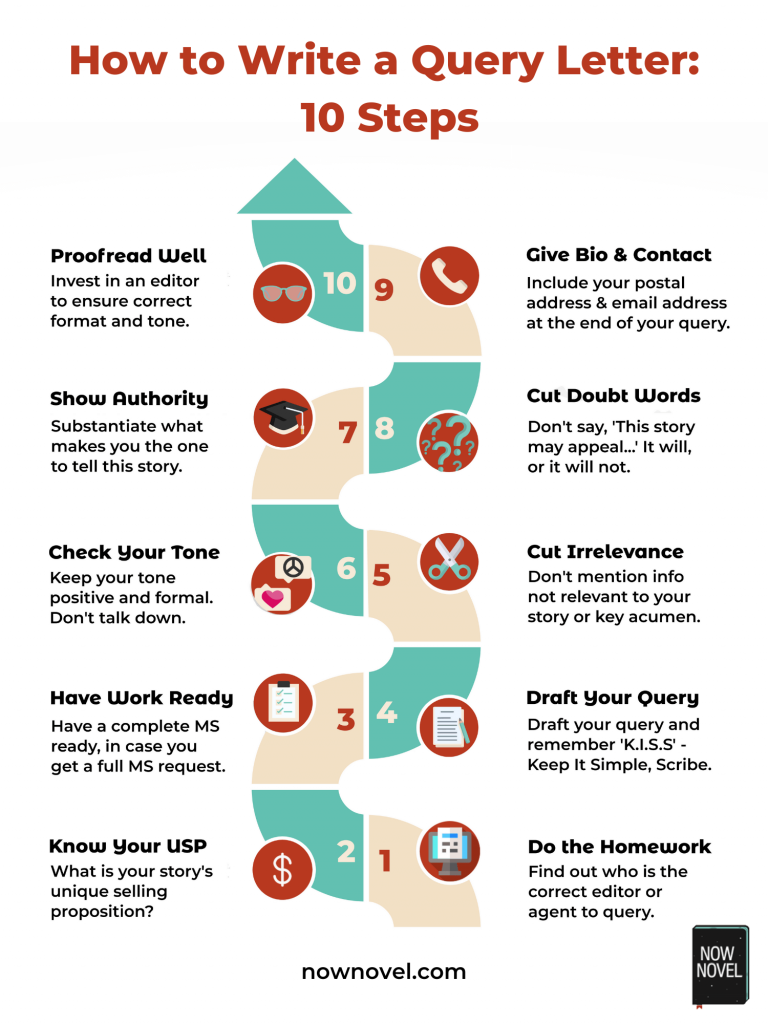Learning how to write a query letter is crucial when you’re seeking an agent and hoping to publish. Read 10 easy steps for writing query letters that convey polish and your story’s USP:
What is a query letter?
A query letter is a formal letter to an agent or editor. It offers a story for publication in a book, journal, magazine or other medium.
Because a query letter has the express purpose of getting your story out there, it’s important to know how to write a query letter that gets manuscript requests.
As Writer’s Market 2020: The Most Trusted Guide to Getting Published says:
The query letter is often the most important piece of the publishing puzzle. In many cases, it determines whether editors or agents will even read your manuscript. A good query makes a good first impression; a bad query earns a swift rejection.
‘Query Letter Clinic’, in Writer’s Market 2020: The Most Trusted Guide to Getting Published, ed. Robert Lee Brewer
10 tips to write a query letter that stands out:
- Do your pre-query homework
- Know your story’s USP and hook
- Have polished writing to send
- Draft your query – K.I.S.S.
- Cut irrelevant waffle
- Keep a positive, inviting tone
- Support your authority
- Remove indecisive doubt words
- Give bio and contact info
- Proofread your query letter
1. Do your pre-query homework
You’ve written a great story. You’d love to bring it to an intended audience.
Before you’ve sent a single query email, do your homework.
Things you should know before querying:
- To whom should you address your query (who will be reading your query letter, and what is their preferred title?)
- Are there guidelines available for query letters for this specific professional or publishing house you should follow?
- Does the addressee have an express interest in the genre or subgenre you’ve written in?
- What recent successes has this individual or publishing house overseen? This will help avoid submitting a very similar concept to something recently optioned and will also help you understand the kinds of stories being sought
- Is the agent legitimate, trustworthy, capable? See Jane Friedman’s guide to finding a literary agent
What if you don’t do research before querying?
A cautionary tale:
You write a beautiful query letter that succinctly sells your unique story idea.
You’ve included writing credits that demonstrate your authority (or supplied other relevant information conveying why you’re the most competent person to tell your story).
Alas, you’ve submitted a work of fantasy or romance to an agent whose focus is non-fiction.
You addressed them as ‘Dear Sir’ (generic – their name and title are a Google away) or ‘Mr Wordsworth’ (and the person in question, now Mz Wordsworth, had a highly public transition 5 years before).
Doing your research about who and where to submit ensures you don’t get an automatic ‘no’ or radio silence before any possibility of a manuscript request even arises.
2. Know your story’s USP and hook
The term ‘USP’ from marketing refers to a product (in this case, a story’s) ‘unique selling proposition’. In selling stories, specifically, the USP is:
- The thing that sets your story apart from others or similar stories
- Something that will make readers want to read, borrow or buy your story
Take, for example, a more ‘gimmicky’ type of story: Pride and Prejudice and Zombies.
The USP of Seth Grahame-Smith’s story is that it takes a beloved Regency novel (Jane Austen’s Pride and Prejudice) and combines it with a popular modern horror subgenre (zombie fic).
It capitalizes on the novelty of modern-day remix or mashup culture, with Newsday calling it ‘the ultimate mash-up’.
How to identify your story’s USP
What is the unique selling proposition that will sell your story to an agent or editor?
One way to find this is to try to condense your story into a one- or two-sentence logline that summarizes what it’s about.
Hawes has a fantastic resource gathering the loglines of NYT bestsellers.
Examples from these lists show how a logline summarizes what a story is about, delivering a sense of its intrigues and its USP:
A doctor serving in the navy in Afghanistan goes back to North Carolina where two women change his life.
Logline for Nicholas Sparks’ The Return
After a divorce, a former Chicago police officer resettles in an Irish village where a boy goes missing.
Logline for The Searcher by Tana French
Exercise: Finding your story’s USP
After reading examples from Hawes’ lists of bestsellers’ loglines, try to write a single sentence summary of your story.
Looking at the examples, try to include interesting information about:
- Key characters
- Pivotal events or turning points (e.g. the doctor’s Afghanistan service and return to NC in Sparks’ book, the Chicago officer’s divorce and relocation to an Irish village in French’s novel)
- Any drama, intrigue or suspense (e.g. the implied turning points in Sparks’s story, or the missing child case in French’s The Searcher)
This exercise may also help you identify your hook – the intriguing scenario that sets your story off and the reader’s curiosity, too.
Editor Jane Friedman in her excellent guide to querying, identifies the hook as one of the four crucial query elements, saying:
The hook [is] the description of your story and the most critical query element; 150-300 words is sufficient for most narrative works.
Jane Friedman, in ‘The Complete Guide to Query Letters’.

3. Have polished writing to send
Before even learning how to write a query letter, you should have something polished enough to send.
Because what if an eager editor requests your first chapters fast (granted, this is uncommon) and they’re a hot mess?
It may be a partial request (often for the first three chapters – enough to see your hook and some development).
Or it could be a full request (and as Friedman says in her guide linked above, this places unnecessary pressure to finish a half-done manuscript faster than may be a comfortable pace).
If you don’t have a complete draft yet, and it’s your first time at the rodeo, take the time to finish your book first.
If you have a complete draft, make sure you’ve had a manuscript evaluation at least by a profssional editor. This includes feedback on SPAG and style issues. If your editor raises many, address these first. It’s a clear sign it’s not time to query – yet.
4. Draft your query – K.I.S.S.
If you’ve done your homework and you a firm idea of your story’s USP and hook, it’s time to draft your query.
Every guide on how to write a query letter includes a form of the old adage ‘K.I.S.S’ (‘Keep it simple, stupid’). In this case, let’s say ‘Keep it simple, scribe’ (a kinder injunction).
What do we mean by this? Remember the following:
- Get to the point (and get there fast). Editors receive many submissions. Concision will help to keep you from the cutting floor.
- Omit self-praise and other florid gestures: Query letters are one place where ‘fake it ’til you make it’ does not apply. Keep mention of prior writing credits verifiable, neutrally-worded and short (no ‘I wrote the best short story ever on Mozart’s big toe though it hasn’t been published yet.’)
- Leave out absent credits: Don’t spend time in your query letter justifying why you don’t have more publishing credits. Agents and editors understand that writers have to start somewhere. Rather use this space to share supporting evidence of what gives you authority to tell this story (relevant experiences, pertinent research).
A good query letter, as the founder of BJ Robbins Literary Agency tells Natalie Collins:
…should be short and to the point, no more than one page. I want to know who you are, what you’ve written, where you’ve studied, and any other pertinent information that will help you stand out from the pack. Avoid cutesy, gimmicky letters or anything overly obsequious or grandiose.
BJ Robbins in conversation with Natalie Collins, via Columbia University’s Fiction Foundry
The Writers Market 2020 edition includes helpful analyses of effective one-page query letters, such as an example of a good fiction book query available via Google Books preview.

5. Cut irrelevant waffle
Once you’ve drafted your query letter, give it several reads over.
Nip and prune wherever your query is too expansive, too tangential, too irrelevant.
A wonderful resource for understanding what in a query letter is essential and what to take out is NY agent and editor Janet Reid’s blog Query Shark.
On her blog, Reid dissects readers’ query letter submissions, identifying what works, what doesn’t, what’s needed, and why.
Reading several submissions and her incisive analysis is instructive. As Reid says, ‘Dig in. Be specific. Use vibrant language. And use it well.’

6. Keep a positive, inviting tone
The content of your story may be cloaks and daggers, girls ripping each other’s teeth out (as per a query submission to Reid’s blog), and worse.
Whatever shade of light or macarbre your story’s content, make sure your query letter itself reads as positive and inviting.
Avoid:
- Manipulative, negative or presumptuous statements about the editor or agent (e.g. ‘You probably won’t read this’. They probably won’t if your query screams negativity.)
- Overly self-deprecating statements or tone (e.g. ‘The story tries to convey…’. It either does convey what it aims to, or doesn’t)
Learning how to write a query letter means learning how to balance giving insightful, revealing, concrete information with keeping a professional, format- and purpose-aware tone.
There’s no place in a query for talking down to the agent or editor, or being hard on your own writing.
7. Support your authority
Authority is an interesting subject in storytelling.
After all, what gives a fantasy writer ‘authority’ to write about dragons, given that they have likely not met any in person?
Learning how to write a query letter means using a variety of ways to convey your authority. This includes:
- Sharing prior writing credits:
Have you had short stories published in reputable magazines or journals? Prior publication is a good sign a writer is neither an amateur nor a chancer (though everyone starts somewhere). - Brief mention of pertinent research:
Say, for example, you’re writing about 1800s London and you spent months scouring government and other historical archives for your story, brief mention of this lends authority – you’ve done your homework to lend your story veracity, credibility.
Jane Friedman mentions other information worth including upfront:
Maybe you’ve been vouched for or referred by an existing client or author; mention the referral right away.
If you met the agent/editor at a conference or pitch event, and your material was requested, then put that upfront
Jane Friedman, ‘The Complete Guide to Query Letters’
Your bio is also a useful place to mention relevant experience or training (for example, a degree or diploma course in creative writing or a related creative background).
8. Remove indecisive doubt words
Your query letter is ideally assured, conveying conviction in your story.
Words to cut from your query:
- Maybe (e.g. ‘You could maybe compare [Title] to [X book] by [author Y]’. Better: ‘In the vein of [X book] by [author Y], [Title] examines…’. Substantiate comparisons and keep them recent!)
- Could (e.g. ‘The story could appeal to…’. It will or it won’t.)
- If [you] (e.g. ‘If you’re interested, please let me know’ – the addressee will let you know if they’re interested)
Instead of words expressing doubt or indecision, remember ‘Keep it simple, scribe’. Convey what’s exciting, unique or interesting about your story upfront. Include the essential query letter information:
- Genre or category
- Title and (if applicable) subtitle
- Word count
- The hook – 150 to 300 words
- Bio (50-100 words – more on this below)
- Brief thank you and closing (e.g. ‘Thank you for your consideration.’)
9. Give bio and contact info
Your bio may add to the inviting element of your query letter.
What is interesting about your background or builds your authority for telling this story? For example, if you have written about druidic clans and you happen to have a degree in Welsh history, this is a good place to mention this relevant detail.
Remember to include your contact information. An example of contact details at the end of a query letter:
Penny Wordsmithery
46 Bibliophile Way
East Cursive, WB 102534
[email protected]
10. Proofread your query letter
Proofread everything. Read it forwards. Read it backwards.
We make mistakes here all the time. Typos are missed. Typos are human. Yet an eagle-eyed literary agent or Big 5 publisher’s in-house editor has the power to be unforgiving. Some may be more so than others.
Make sure your query letter and submission chapters are polished – get professional editing.


4 replies on “How to write a query letter: 10 easy steps”
Very helpful and interesting article, as always! Thank you.
I have a question though. An author has to support his authority. But what if it’s my first novel and I don’t have any relevant background or degrees to substantiate my authority? In one of your examples you say that I can mention time spent on research. Is that a valuable strategy for a tyro?
Hi Max, thank you, I’m glad you found this helpful. That’s a great question. Many editors and agents advise several ways to demonstrate authority:
1) Write briefly about what makes you an authority to tell this story (for example, if you spent 3 years serving in the marines and there were martial elements in a story, this would be a good place to mention this briefly as experiences that inspired the book).
2) Mention any smaller publications (it’s worth writing and submitting short stories as a precursor to querying a novel, both for the submissions/querying experience and to be able to say your work has appeared here and there).
If you don’t have anything specific demonstrating authority, you can also simply say ‘This is Max’s first novel’. If a debut is good, well-edited and engaging, that in itself may impress an agent or commissioning editor or senior manager, and being marketed as a debut author would factor into promotion.
I hope this helps!
Hi Jordan – the link to Penguin’s guide to evaluating agent information is broken. Could you locate and post the correct link by any chance? Thanks much!
Hi Laura, thank you for notifying me. I have replaced that link with Jane Friedman’s equally helpful guide to literary agents since it would appear Penguin has removed that resource since this article was first published. I hope you find the alternative resource useful.